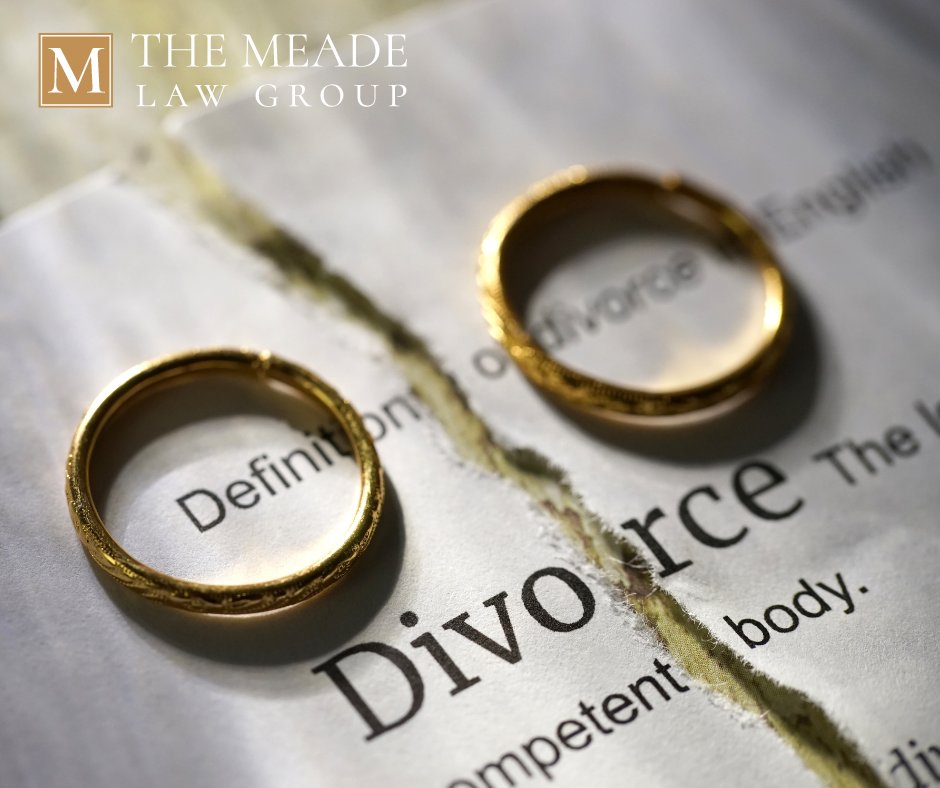Divorce is an emotionally challenging time, filled with uncertainty and complex decisions. One of the most significant concerns for divorcing couples is how to fairly divide their assets and debts. Here at The Meade Law Group, we understand the importance of navigating this process with clarity and confidence. We have extensive experience as [Link to Ohio Divorce Lawyer Page] in family law, especially in divorce, and we’re here to guide you through every step of asset and debt division in Ohio.
Many people assume a 50/50 split is the norm during a divorce. But that is not how it works in Ohio. The state uses a foundational legal principle called “equitable distribution,” which means dividing marital assets and debts fairly, not necessarily equally.
This blog post provides a comprehensive roadmap to understanding equitable distribution and how it applies to your divorce. We’ll delve into the key factors a judge considers, the critical distinction between marital and separate property, the complexities of debt division, and the importance of professional valuation. By the end, you’ll have a clearer picture of this process and the strategic steps necessary to secure a fair outcome.
What is Equitable Distribution?
Equitable distribution in Ohio divorce is a legal concept that prioritizes a fair division of marital assets and debts, rather than a mandatory 50/50 split. This approach is different from community property states, which require an automatic, rigid 50/50 division of marital property, regardless of the circumstances of the marriage.
This distinction is essential. Equitable distribution empowers the court to look beyond simple arithmetic and consider the unique context of your marriage. The court evaluates several factors to ensure a just outcome:
- The length of the marriage
- The contributions of each spouse (both financial and non-financial)
- The future needs of any children involved
By taking these elements into account, equitable distribution aims to achieve a balanced financial outcome. This measured approach helps to ensure that each spouse has a reasonable opportunity for financial stability as they move forward after the divorce.
Marital vs. Separate Property: Understanding the Divide
Equitable distribution only applies to marital property, which is essentially all assets and debts acquired during the marriage. Before dividing these, it’s crucial to understand what constitutes separate property, assets that are exempt from division. Ohio Revised Code Section 3105.171(A)(6)(a) defines separate property as:
- Assets owned before marriage: Any property (real estate, vehicles, investments) you possessed individually prior to the marriage.
- Gifts and inheritances: If you receive a gift or inheritance during the marriage, it is generally considered separate property, as long as it was intended for you specifically.
- Income from separate property: Any income generated directly from your separate property (e.g., rental income from a pre-marital house) remains separate property.
- Personal injury awards: Compensation you receive for physical or emotional injuries is typically considered separate property.
- Property acquired after legal separation: Assets obtained after a legal separation order are considered separate property.
- Prenuptial agreements: A properly drafted prenuptial agreement can legally designate specific assets as separate property, overriding the default rules of equitable distribution.
Protecting Your Separate Property: Documentation is Key
It’s important to note that commingling separate and marital funds can easily blur the lines. For example, if you deposit a pre-marital inheritance (separate funds) into a joint bank account where marital funds are also deposited, the court may view the inheritance as having been converted into marital property.
To ensure your separate assets are protected, meticulous documentation is non-negotiable. You must be able to trace the origin of those funds or assets back to a pre-marital date or an inheritance/gift. An experienced family law attorney, like those at The Meade Law Group, can help you navigate this complex process of tracing and documentation to ensure your separate assets are properly identified and protected throughout the equitable distribution process.
Factors Considered in Equitable Distribution: The Judge’s Balancing Act
While the goal of equitable distribution is a fair outcome, it is explicitly not a guaranteed 50/50 split. Ohio courts consider several factors when dividing marital assets and debts, aiming for a balanced result. Let’s explore some of the key factors that weigh on the court’s decision:
- Duration of the Marriage (Ohio Revised Code Section 3105.171(F)(1)): Longer marriages tend to result in a more intertwined financial picture, potentially influencing the distribution toward a closer split.
- Assets and Liabilities of the Spouses (Ohio Revised Code Section 3105.171(F)(2)): The court analyzes the total value of the marital estate (houses, vehicles, retirement accounts, investments, and debts accumulated during the marriage) to determine a fair division.
- Contributions of Each Spouse (Ohio Revised Code Section 3105.171(F)(3)): The court considers both financial contributions (wages, inheritances) and non-financial contributions (homemaking, childcare). Did one spouse prioritize raising children while the other built a career? This can be factored into the equation.
- Economic Circumstances of Each Spouse (Ohio Revised Code Section 3105.171(F)(4)): The court takes a forward-looking approach, considering each spouse’s future earning capacity, employability, and potential for acquiring future assets to ensure both parties have a reasonable chance at financial stability after the divorce.
- Tax Implications (Ohio Revised Code Section 3105.171(F)(8)): Dividing assets like retirement accounts can have tax consequences. The court may consider these implications to minimize tax burdens for both spouses.
These are just the primary factors considered. The court has the discretion to weigh additional factors specific to your situation (Ohio Revised Code Section 3105.171(F)(9)).
Valuation of Complex Assets: Knowing Your Worth
The biggest pitfall in equitable distribution is often not the division itself, but the valuation of assets. For simple assets like bank accounts, valuation is straightforward. However, for complex assets, accurate valuation is critical to ensuring you receive a fair share.
Complex assets frequently require professional appraisal and may include:
- Business Interests: Valuing a closely held business, partnership, or professional practice. This often requires forensic accounting.
- Retirement Accounts: Valuing pensions, 401(k)s, and IRAs, which may require a Qualified Domestic Relations Order (QDRO) to divide them without tax penalties.
- Stock Options and Restricted Stock Units (RSUs): Determining the marital portion of these future-earning instruments.
- Real Estate: Appraising the marital home, investment properties, and vacation homes.
If complex assets are involved, The Meade Law Group will work with trusted financial experts and valuation professionals to ensure these assets are correctly identified and valued, allowing for a truly equitable split.
Debt Division in Ohio: Sharing the Burden
Equitable distribution extends to marital debts as well. In Ohio, debts incurred during the marriage (mortgages, car loans, credit card balances) are generally considered marital debts and are subject to division between the spouses.
The key takeaway is that, in most cases, these marital debts will be divided equally. However, the court may deviate from a 50/50 split if it deems it unfair based on several factors:
- Who Incurred the Debt: Did one spouse take on a significant debt solely for their own benefit (e.g., gambling debts)? The court may assign a larger portion of that debt to the responsible spouse.
- Benefit from the Debt: Did both spouses benefit from a particular debt? A mortgage on the marital home would likely be divided equally.
- Financial Circumstances: If one spouse has a significantly higher income or future earning capacity, they may be assigned a larger portion of the debt to ensure a more equitable outcome.
Remember, transparency and detailed documentation are crucial. Gather all statements for marital debts, including credit reports. Working with a skilled family law attorney helps ensure all relevant factors are considered when dividing marital debts, protecting your financial future after the divorce.
Achieving a Fair Asset and Debt Division in Ohio
The path to a fair asset and debt division in Ohio relies on preparation, valuation, and skillful negotiation. Whether your case involves commingled funds, complex business interests, or significant marital debt, the goal remains the same: ensuring your financial contributions to the marriage are properly recognized and protected.
Getting Legal Help: Your Trusted Guide Through Equitable Distribution
Navigating the complexities of equitable distribution in a divorce can be daunting. The legal nuances, the emotional toll, and the sheer volume of paperwork can easily overwhelm even the most level-headed individual. That’s where a qualified family law attorney steps in as your trusted advisor and advocate.
Here’s how an experienced attorney at The Meade Law Group makes a significant difference in your Ohio divorce:
- Understanding Your Rights: We’ll provide a clear explanation of Ohio’s equitable distribution laws and how they apply to your specific situation.
- Identifying and Valuing Assets and Debts: Our team will meticulously identify all marital assets and debts, ensuring a complete financial picture. We collaborate with experts to value complex assets.
- Negotiating a Fair Settlement: Skilled negotiation is key in achieving a settlement that reflects your needs and objectives. Your attorney will represent you effectively during negotiations, advocating tirelessly for a fair division of marital assets and debts.
- Courtroom Representation (if necessary): Should your case proceed to trial, having a seasoned attorney in your corner is invaluable. We will represent you confidently in court, presenting your case persuasively before the judge. [Link to Family Law Services]
You’ve worked hard to build your life, don’t let uncertainty about property division put your future at risk. The Meade Law Group understands that divorce is a challenging experience. We are committed to providing compassionate and strategic legal guidance throughout the process.
Schedule your consultation with The Meade Law Group today and take the first confident step toward a fair resolution. Don’t face this alone – let our experienced legal team guide you with clarity and confidence.


